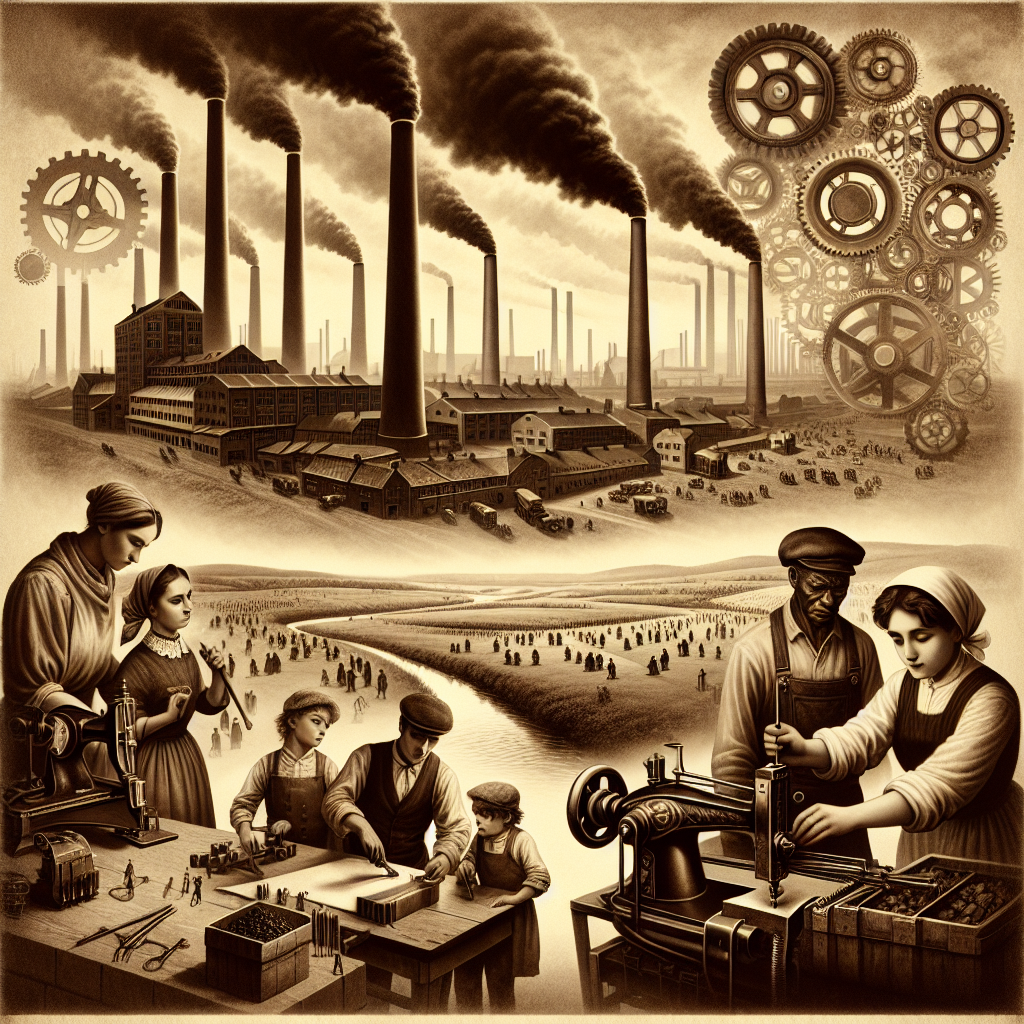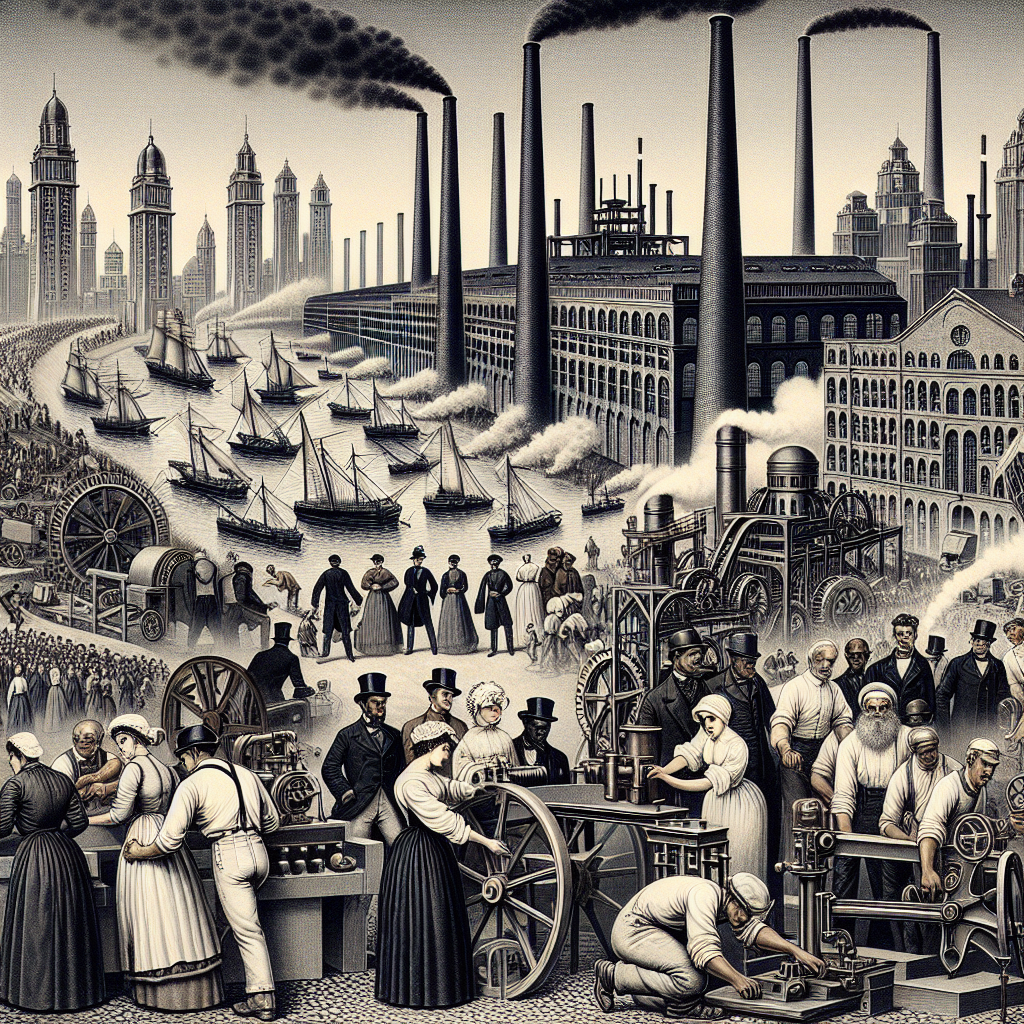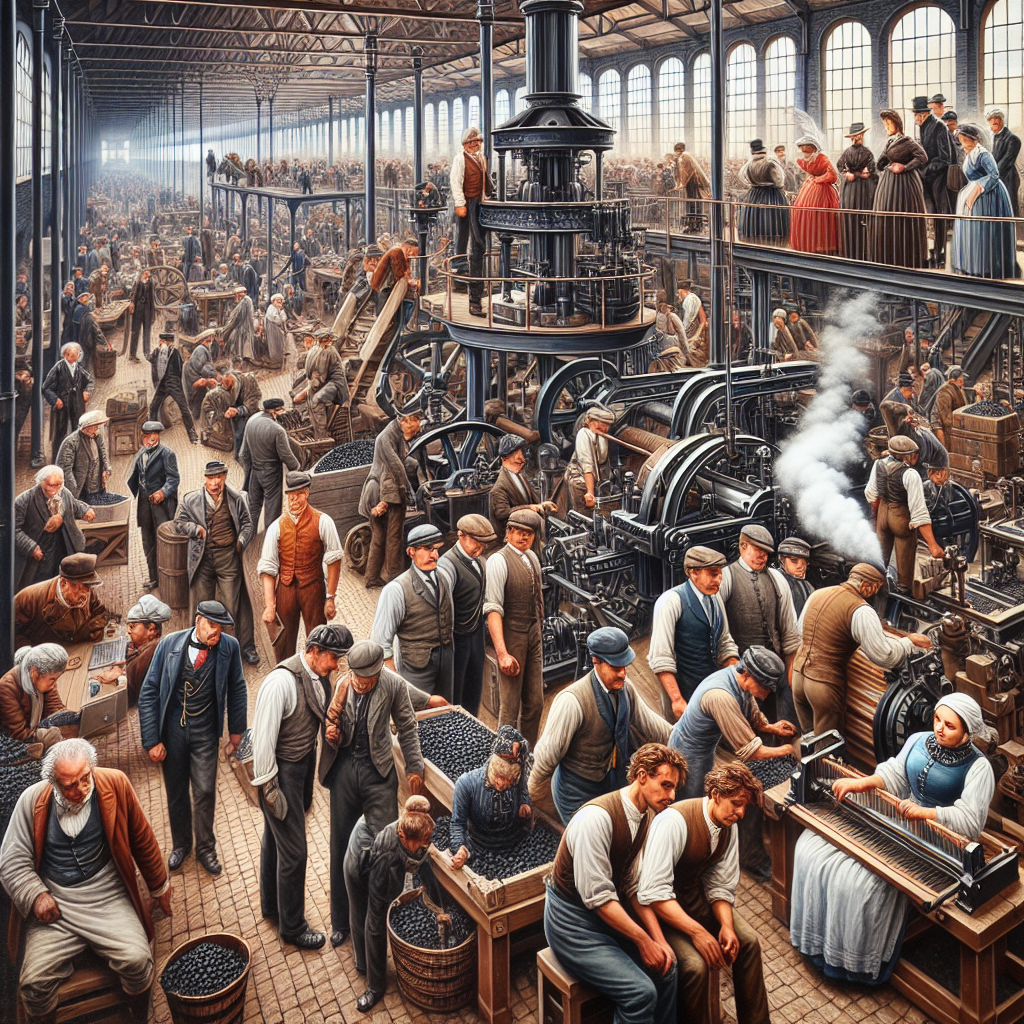The Industrial Revolution in Europe was a period of unprecedented growth, innovation, and transformation that forever changed the economic, social, and technological landscape of the continent. During this era, which spanned from the late 18th to the early 19th century, Europe saw the emergence of mechanized factories, steam engines, and new methods of production that revolutionized industries such as textiles, transportation, and agriculture. The Industrial Revolution not only led to the urbanization of society but also sparked significant changes in labor practices, education, and living standards. Join us as we delve into this transformative era and unravel the secrets behind Europe’s industrial evolution.
The Pre-Industrial European Landscape
In exploring the landscape of pre-industrial Europe, it becomes evident that the societal structure was primarily rooted in agriculture and cottage industries, with minimal technological advancements shaping the economy and daily life of the population. This era was characterized by:
-
Agricultural society: The majority of the European population was engaged in agricultural activities, with farming serving as the primary means of sustenance and livelihood for communities across the continent. Land cultivation, animal husbandry, and crop production were fundamental to the economic framework of pre-industrial Europe.
-
Cottage industries: Alongside agriculture, cottage industries played a significant role in the pre-industrial European landscape. Artisans and craftsmen operated out of their homes or small workshops, producing goods such as textiles, pottery, and metalwork. These decentralized production methods were prevalent before the industrial revolution centralized manufacturing processes.
-
Limited technological advancements: Technological innovation was notably constrained during this period, with traditional methods and tools being predominantly utilized in both agricultural and industrial practices. The absence of mechanization and automation hindered the efficiency and scale of production, shaping a labor-intensive and resource-dependent economic system.
By examining the pre-industrial European landscape through the lens of agriculture, cottage industries, and technological limitations, we gain valuable insight into the foundational structures that set the stage for the transformative era of the Industrial Revolution.
Factors Leading to Industrial Revolution
The Pre-Industrial European Landscape
- Population growth
- The period preceding the Industrial Revolution witnessed a significant increase in the population of Europe. This demographic shift was fueled by improvements in healthcare, sanitation, and agricultural practices, leading to a larger labor force available for industrial production.
-
The rising population created a greater demand for goods and services, prompting entrepreneurs to seek innovative ways to meet these needs efficiently.
-
Urbanization
- Urban centers across Europe experienced rapid growth as people migrated from rural areas in search of employment opportunities in emerging industries.
-
The concentration of people in cities facilitated the exchange of ideas and resources, fostering a conducive environment for technological advancements and industrial development.
-
Capital accumulation
- The accumulation of capital through various means, such as trade, colonial ventures, and investments, provided the financial resources necessary to fund industrial enterprises.
- Wealthy individuals and institutions capitalized on economic opportunities, investing in new technologies and ventures that laid the foundation for the industrial transformation of Europe.
Technological Innovations Driving Change

The Industrial Revolution in Europe was characterized by a wave of groundbreaking technological innovations that revolutionized the production processes across various industries. These innovations played a pivotal role in driving unprecedented economic growth and societal transformation during this transformative era.
Steam Engine
The invention and widespread adoption of the steam engine marked a significant turning point in human history. Developed by James Watt in the late 18th century, the steam engine enabled factories to mechanize their operations and significantly increase their productivity. By harnessing the power of steam, industries such as textiles, transportation, and mining were able to operate more efficiently and on a much larger scale than ever before.
Textile Machinery
The introduction of textile machinery, such as the spinning jenny and the power loom, revolutionized the textile industry in Europe. These machines automated the process of spinning and weaving cloth, drastically reducing the time and labor required to produce textiles. As a result, the textile industry experienced exponential growth, leading to the establishment of large-scale factories and the mass production of textiles.
Iron and Coal Industries
The iron and coal industries played a crucial role in fueling the Industrial Revolution. The development of new technologies, such as the puddling process for refining iron and the use of coke in iron production, transformed the iron industry and paved the way for the mass production of iron goods. Additionally, the mining and utilization of coal as a source of energy were instrumental in powering the steam engines that drove industrial machinery and locomotives.
In conclusion, the technological innovations of the Industrial Revolution in Europe were instrumental in driving unprecedented economic growth, transforming traditional industries, and shaping the modern world as we know it today.
Impact on Transportation and Communication
The Industrial Revolution brought forth a wave of technological innovations that revolutionized transportation and communication systems across Europe. These advancements played a pivotal role in shaping the modern world as we know it today.
Steam-powered locomotives
- Steam-powered locomotives emerged as a game-changer in the transportation sector during the Industrial Revolution. These iron giants replaced traditional horse-drawn carriages and significantly expedited travel between cities and regions.
- The introduction of steam-powered trains led to the establishment of railway networks, connecting industrial hubs and facilitating the swift movement of goods and people. This revolutionized trade and commerce, boosting economic growth and industrial development.
Telegraph system
- The advent of the telegraph system marked a milestone in communication technology. It enabled near-instantaneous transmission of messages over long distances, transforming the way information was shared and disseminated.
- The telegraph system facilitated real-time communication between businesses, governments, and individuals, fostering greater connectivity and efficiency in various sectors. This rapid exchange of information laid the groundwork for the global communication networks we rely on today.
Canals and roads development
- In addition to the advancements in rail transport, the Industrial Revolution also witnessed significant developments in canals and roads infrastructure. Canals were dredged and expanded to facilitate the transportation of goods, particularly raw materials and finished products.
- Improved road networks were constructed to enhance inland transport and connectivity between urban centers. These developments not only facilitated the movement of goods but also spurred urbanization and regional integration, paving the way for further industrial expansion and economic prosperity.
Economic and Social Transformations
The Industrial Revolution in Europe brought about significant economic and social transformations that reshaped the fabric of society during the 18th and 19th centuries. The transition from traditional artisanal methods to the factory system revolutionized production processes and had far-reaching effects on various aspects of daily life.
Shift to Factory System
- Introduction of mechanized production: The advent of machinery powered by steam and later electricity mechanized production, leading to increased efficiency and output.
- Centralization of production: Factories emerged as central hubs of production, concentrating workers in urban areas around manufacturing facilities.
- Division of labor: Specialization became prevalent as tasks were divided among workers, streamlining processes but also reducing the autonomy of individual workers.
Labor Conditions and Urbanization
- Impact on labor: The factory system introduced longer working hours and often harsh working conditions, with workers laboring in crowded and hazardous environments.
- Urban migration: The lure of employment in factories drew people from rural areas to burgeoning industrial cities, fueling rapid urbanization and the growth of urban slums.
- Social implications: The influx of rural migrants into cities led to overcrowding, poor sanitation, and heightened social tensions, as disparities between the wealthy factory owners and the impoverished working class became more pronounced.
Class Divisions and Social Unrest
- Emergence of social classes: The Industrial Revolution gave rise to distinct social classes, with industrialists and factory owners accumulating wealth and power, while workers faced low wages and precarious employment.
- Labor movements: Dissatisfaction with working conditions and inequities spurred the formation of labor unions and the organization of strikes and protests, as workers sought to improve their rights and conditions.
- Government responses: The period was marked by social unrest and clashes between labor and capital, prompting governments to introduce labor reforms and regulations to address some of the grievances raised by the working class.
Influence on Global Trade and Colonialism
The Industrial Revolution in Europe had a profound impact on global trade and colonialism during the transformative era. This period marked a significant shift in economic and social structures, leading to the expansion of markets, the rise of imperialism, and increased competition among European powers.
Expansion of Markets
- Technological advancements: The Industrial Revolution introduced new technologies such as steam engines, mechanized looms, and railways, enabling mass production and faster transportation of goods.
- Increased productivity: With the mechanization of industries, European countries were able to produce goods on a larger scale, leading to a surplus that could be traded globally.
- Emergence of consumer culture: The availability of a wide range of manufactured products fueled consumer demand, both domestically and in overseas markets.
Imperialism
- Quest for resources: European powers sought to expand their empires to secure access to raw materials needed for their industries, such as cotton, rubber, and minerals.
- Establishment of colonies: Countries like Britain, France, and Germany established colonies in Africa, Asia, and the Americas to exploit resources, establish trading posts, and create captive markets for their goods.
- Political dominance: Through colonization, European nations exerted political control over vast territories, shaping the geopolitical landscape and influencing global trade patterns.
Competition among European Powers
- Race for colonies: The scramble for colonies led to intense rivalries among European powers, with each vying for territorial expansion and economic supremacy.
- Trade wars: Nations competed for control of strategic trade routes and markets, leading to conflicts and alliances that reshaped the balance of power in Europe and beyond.
- Innovation and industrial espionage: To gain a competitive edge, countries invested in research and development, while also engaging in espionage to acquire technological secrets from rivals.
In conclusion, the Industrial Revolution in Europe not only revolutionized production processes and social structures but also had far-reaching consequences on global trade and colonial expansion, shaping the modern world order.

Intellectual and Cultural Shifts
Enlightenment Ideals
The Enlightenment period in Europe, spanning from the late 17th to 18th centuries, was marked by a surge in intellectual and philosophical pursuits. Thinkers such as Voltaire, Rousseau, and Locke championed reason, individualism, and skepticism towards traditional authority. These ideals emphasized the power of human reason to challenge prevailing beliefs and institutions, laying the groundwork for questioning established norms and fostering a spirit of innovation.
Scientific Advancements
The Industrial Revolution in Europe was greatly influenced by the preceding scientific advancements of the Enlightenment era. Pioneering figures like Isaac Newton, Galileo Galilei, and Johannes Kepler revolutionized the understanding of the natural world through empirical observation and mathematical reasoning. Their discoveries in physics, astronomy, and mathematics provided the theoretical framework for technological innovations that would later propel industrialization forward.
Rise of Industrial Capitalism
One of the profound cultural shifts during the Industrial Revolution was the rise of industrial capitalism as the dominant economic system in Europe. Capitalism, characterized by private ownership of the means of production and the pursuit of profit, fueled the rapid expansion of industries and trade networks. This transition from agrarian and artisanal economies to factory-based production systems not only reshaped economic structures but also transformed social dynamics and class relations in European societies.
Challenges and Responses
-
Luddite Movement
The Luddite movement emerged as a direct response to the rapid industrialization and mechanization taking place during the Industrial Revolution in Europe. Luddites were primarily skilled textile workers who feared that the introduction of new machinery would render their traditional craft obsolete, leading to unemployment and a decline in the quality of their work. This movement manifested in acts of sabotage against factories and machinery, highlighting the tensions between technological advancement and the livelihoods of workers. -
Reform Movements
Amidst the social and economic upheaval brought about by the Industrial Revolution, various reform movements emerged in Europe. These movements sought to address the harsh working conditions, child labor, and exploitation prevalent in factories and mines. Reformers advocated for legislative changes to improve labor laws, regulate working hours, and ensure better wages for workers. The push for labor rights and social reforms reflected the growing awareness of the need for humanitarian considerations in the midst of industrial progress. -
Intellectual Critiques and Social Reforms

Intellectual critiques of the Industrial Revolution in Europe stemmed from thinkers such as Karl Marx and Friedrich Engels, who analyzed the impact of capitalism on society. Their works highlighted the widening wealth gap, exploitation of labor, and alienation of workers in industrialized economies. These critiques fueled calls for social reforms aimed at addressing inequality and improving the living and working conditions of the working class. Movements advocating for socialism and communism gained traction as alternatives to the capitalist system that characterized the Industrial Revolution era.
Legacy of the Industrial Revolution
The Industrial Revolution in Europe left a profound legacy that continues to shape the modern world in various ways.
-
Modern industrialized society
The Industrial Revolution marked a significant shift from agrarian economies to industrialized societies. This transformation brought about the mass production of goods, the establishment of factories, and the mechanization of processes. As a result, there was a rapid urbanization as people moved from rural areas to cities in search of employment opportunities in the burgeoning industries. This shift laid the foundation for the complex and interconnected global economy that we see today, with specialized industries, division of labor, and increased efficiency in production processes. -
Environmental impact
However, this rapid industrialization also had severe consequences on the environment. The burning of fossil fuels to power factories and machinery led to increased air pollution, deforestation, and depletion of natural resources. The Industrial Revolution marked the beginning of large-scale environmental degradation, which continues to be a pressing issue in the modern era. The legacy of the Industrial Revolution serves as a reminder of the importance of balancing economic development with environmental sustainability. -
Continued technological advancements
Moreover, the innovations and technological advancements that emerged during the Industrial Revolution laid the groundwork for further progress in science and technology. The development of steam engines, railroads, and new manufacturing techniques revolutionized transportation, communication, and production processes. These advancements not only propelled economic growth during the Industrial Revolution but also paved the way for future innovations in the fields of engineering, medicine, and communication. The legacy of technological advancements from the Industrial Revolution continues to shape our modern world, with ongoing research and development building upon the foundations laid during this transformative era.
FAQs: The Industrial Revolution in Europe
What was the Industrial Revolution in Europe?
The Industrial Revolution in Europe was a period of significant economic and technological advancement that took place from the late 18th to the early 19th century. It was characterized by the transition from agrarian-based economies to industrialized ones, marked by the rise of factories, mechanized production, and technological innovations like the steam engine.
What were some key factors that contributed to the Industrial Revolution in Europe?
Several factors played a crucial role in driving the Industrial Revolution in Europe, including the availability of natural resources like coal and iron ore, the growth of cities and urbanization, the invention of new machines and technologies, and the development of transportation infrastructure such as railways and canals.
How did the Industrial Revolution impact society in Europe?
The Industrial Revolution had a profound impact on European society, bringing about significant social and economic changes. While it led to increased production and economic growth, it also resulted in harsh working conditions for many laborers, particularly in factories. The rise of industrial capitalism also widened the wealth gap between the rich and the poor, leading to social unrest and calls for labor reform.
What were some of the major innovations and inventions that emerged during the Industrial Revolution in Europe?
The Industrial Revolution in Europe saw the emergence of several groundbreaking inventions and innovations, including the steam engine, the spinning jenny, the power loom, the cotton gin, and the telegraph. These technological advancements revolutionized industries such as textiles, transportation, and communication, transforming the way goods were produced and distributed.
How did the Industrial Revolution in Europe impact global trade and colonization?
The Industrial Revolution in Europe played a significant role in shaping the course of global trade and colonization. European countries like Britain, France, and Germany leveraged their industrial capabilities to expand their empires and establish colonies in regions rich in natural resources. This led to the exploitation of indigenous populations and the growth of international trade networks that fueled further industrialization.
0 Comments